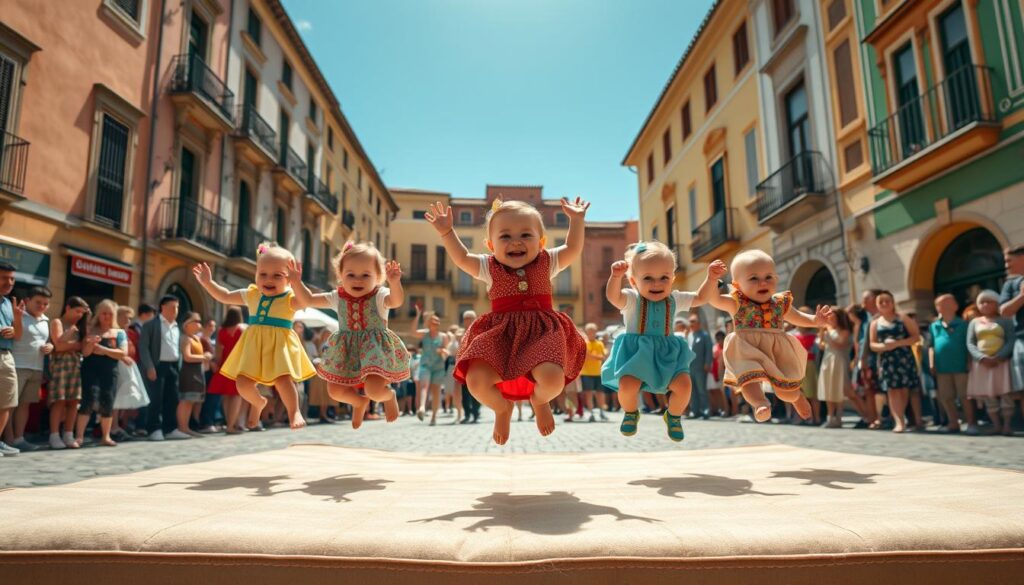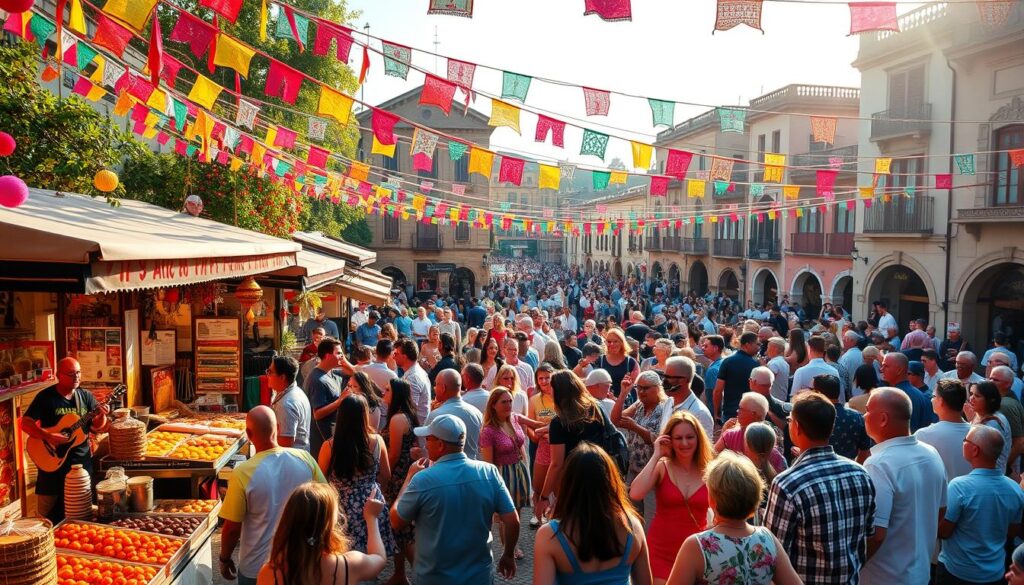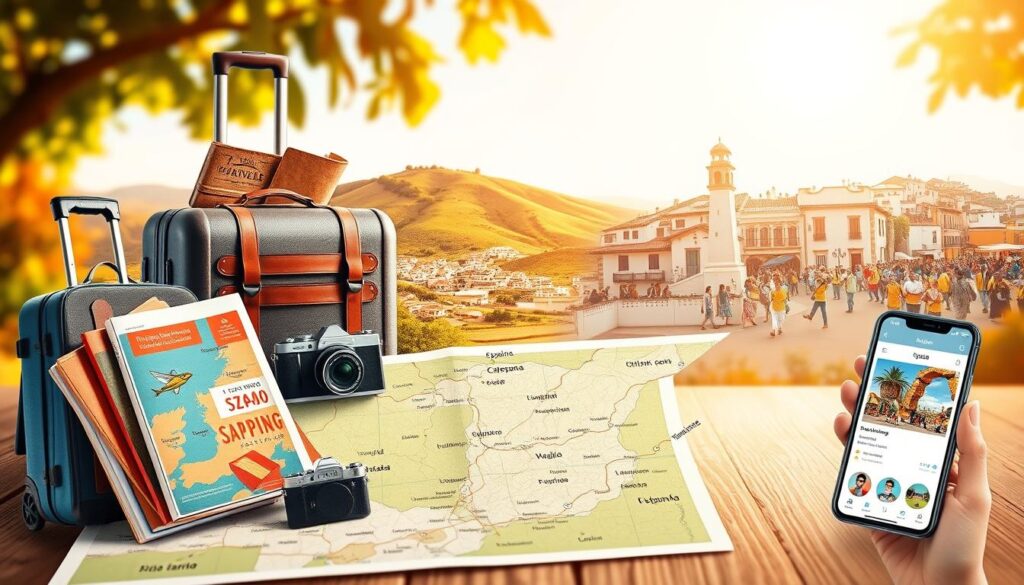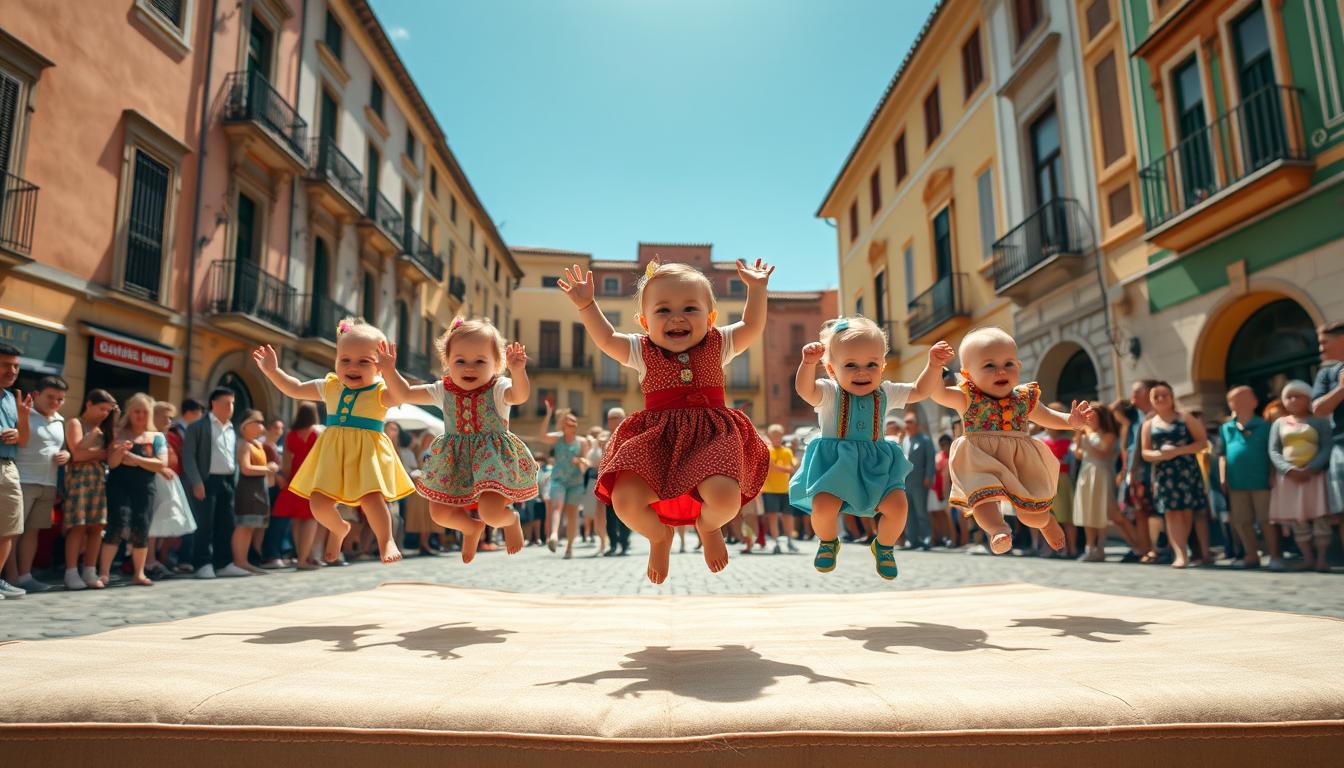The baby jumping festival, also known as El Colacho, is a unique event in Spain. It happens in Castrillo de Murcia. This tradition is centuries old and shows Spain’s rich culture.
During the festival, men dressed as devils jump over babies. This is to cleanse them of original sin. It’s a thrilling sight that anyone interested in El Colacho should see.

The baby jumping festival draws tourists from all over. El Colacho is a big part of Spain’s culture. Seeing it live is a chance to explore Spain’s history and traditions.
Whether you’re into the baby jumping festival or just want to learn about Spanish festivals, this event will impress you.
Key Takeaways Baby Jumping Festival
- The baby jumping festival, or El Colacho, is a unique Spanish festival that takes place in Castrillo de Murcia.
- Men dressed as devils jump over babies to cleanse them of original sin during the festival.
- El Colacho is a centuries-old tradition that is part of Spain’s rich cultural heritage.
- The baby jumping festival is one of the many Spanish festivals that attract tourists from around the world.
- Experiencing the festival firsthand provides an opportunity to delve into Spain’s history and traditions.
- The festival is a thrilling experience that showcases the country’s unique cultural significance.
Understanding the Baby Jumping Festival in Spain
The Baby Jumping Festival, also known as El Colacho, is a special event in Spain. It shows the country’s rich cultural traditions. This festival is a big part of Spanish culture, showing how important unique celebrations are in the country’s heritage.
It has its roots in medieval Spain. Over time, it has changed, influenced by the country’s history and Spanish culture.
Some key aspects of the festival include:
- Its origins in medieval Spain, where it was believed to have cleansing properties for babies
- Its religious significance, tied to the Catholic tradition of cleansing babies of original sin
- Its cultural impact, including its role in Spanish folklore and its influence on local customs and traditions
The festival’s history and significance are deeply tied to Spain’s cultural traditions and unique celebrations. It’s a key part of Spanish culture. By learning about the Baby Jumping Festival, we can appreciate the importance of keeping cultural heritage alive. Festivals like El Colacho help shape a nation’s identity.
The Fascinating History Behind This Ancient Tradition
Spanish history is filled with unique cultural traditions, and festivals play a big role in this. The Baby Jumping Festival, or El Colacho, is a key example. It shows how festivals and cultural heritage are deeply connected in Spain.
Looking into El Colacho’s history, we see it’s more than just a quirky event. It’s a vital part of Spanish culture, dating back to medieval times. The festival has grown, influenced by many cultural and religious traditions in Spain. It’s linked to other famous events like Tomatina and the Running of the Bulls, showing Spain’s rich cultural tapestry.
El Colacho’s importance in Spanish history and culture is huge. It shows Spain’s ability to keep its unique traditions alive, even with modern changes. By exploring this tradition, we learn more about the role of festivals in shaping Spanish culture and identity.
- Its origins in medieval times
- Its connection to other cultural and religious traditions in Spain
- Its significance in Spanish cultural heritage and identity
This highlights the depth and richness of Spanish history and culture. It shows why it’s crucial to keep traditions like El Colacho alive.
When and Where the Festival Takes Place
Travelers eager to see the Baby Jumping Festival need to plan early. Knowing the festival schedule is key. This event is a big draw for Spanish tourism, bringing people from everywhere to these travel destinations.
Festival Details
The festival happens in Castrillo de Murcia. Visitors can dive into the fun and learn about the area’s culture. Here’s what to keep in mind:
- Check the festival schedule early to plan your trip
- Look for places to stay near Castrillo de Murcia
- Discover the local culture and traditions that make Spanish tourism special
Location and Time
The festival is in June. Visiting then lets you see everything. Castrillo de Murcia is a top travel destination. Its festival schedule is a big part of Spanish tourism.
The Ritual and Performance of El Colacho
El Colacho is a special part of Spanish folklore. It’s a ritual where men dressed as devils jump over babies on a mattress. This act is meant to purify the infants. It’s a key part of Spanish culture, showing the country’s rich heritage.
The men playing devils go through a lot of training. They learn to jump over the babies safely. The music and dance that go with the ritual make the event even more special.
El Colacho brings people together, creating a sense of unity. It celebrates Spanish folklore, reminding everyone of the country’s history and traditions. This event is a must-see for anyone interested in Spanish culture.
Some key aspects of the El Colacho ritual include:
- The selection of the “devils” who participate in the jumping ritual
- The preparation and training of the participants
- The cultural performances that accompany the ritual
- The significance of the ritual in Spanish folklore
The ritual and performance of El Colacho show Spain’s lively cultural scene. It highlights the need to keep traditional customs alive. By seeing El Colacho, visitors can learn more about Spanish folklore and its role in the country’s identity.
Safety Measures and Festival Organization
The Baby Jumping Festival, also known as El Colacho, is a thrilling event. It needs careful planning to keep everyone safe. Festival safety is a top priority, with measures to protect the babies and the men jumping over them.
Medical professionals are on site to help quickly if needed. This is a key part of keeping everyone safe.
Community involvement is key to the festival’s success. Local residents help organize and take part in the event. This involvement creates a sense of belonging and responsibility.
It makes the festival safer and more enjoyable for all. Cultural events like El Colacho are vital to Spain’s heritage. The organizers work hard to keep the event respectful and true to its traditions.
- Medical supervision by trained professionals
- Strict guidelines for the men who jump over the babies
- A safe and controlled environment for the babies and their families
These steps make sure the festival is fun and safe for everyone. They also help keep the cultural traditions alive.
What to Expect as a Festival Visitor
Getting ready for the Baby Jumping Festival? It’s key to know what to expect. This festival lets you dive into local culture and traditions. Make sure you have the right tourist information and follow cultural etiquette.
At the festival, you’ll see traditional rituals and shows. It’s a perfect time to take photos and meet locals. But, it’s important to respect local customs for a good time for everyone.

- Arrive early to get a good spot
- Respect local customs and traditions
- Use tourist information to plan your visit
- Interact with locals and learn about cultural etiquette
Following these tips lets you enjoy the festival experience fully. Stay informed and plan well for a memorable visit.
Traditional Customs and Celebrations Around the Event
The Baby Jumping Festival is filled with traditional customs that are key to the event. It showcases music, dance, and food, all rooted in Spanish heritage. These customs and celebrations draw visitors from around the globe.
Important traditional customs include wearing traditional clothes, making special foods, and dancing. These traditions are a big part of the festival’s identity. They are kept alive through generations.
The festival also has cultural celebrations like live music and dance. These performances highlight Spanish heritage. Visitors can try traditional foods and drinks, like local specialties.
In summary, the Baby Jumping Festival is a unique event. It offers a peek into traditional customs and cultural celebrations of Spanish heritage. It’s a must-see for those interested in Spain’s rich cultural heritage.
Travel Tips and Accommodation Information
Planning a trip to the Baby Jumping Festival in Spain needs some research and prep. To enjoy your trip fully, knowing the right travel tips and accommodation information is key. Spanish tourism has many choices, from cheap hostels to fancy hotels.
Getting to the festival has several ways. You can fly to the nearest airport and then take a bus or taxi. Or, you can take a train or drive. Here are some tips to help you get there:
- Book your flights and accommodation early to save money and find a place.
- Look up the best ways to get from the airport to the festival.
- Think about renting a car if you want to see more of the area.
For accommodation information, you have many choices like hotels, hostels, and vacation rentals. Make sure to book early to get a spot. Also, think about how close it is to the festival.

Once you get to the festival, use local transport like buses or taxis. You can also walk or bike, depending on where it is. With these travel tips and accommodation information, you’re set for a great time at the Baby Jumping Festival. It’s a special part of Spanish tourism.
| Transportation Option | Cost | Duration |
|---|---|---|
| Bus | $10 | 30 minutes |
| Taxi | $20 | 20 minutes |
| Car Rental | $50 per day | Varies |
Conclusion: Preserving Spain’s Unique Cultural Heritage
As we say goodbye to the “Baby Jumping Festival” in Spain, we must think about keeping the country’s rich culture alive. This old tradition, El Colacho, shows how strong and varied Spanish culture is. By protecting events like this, we make sure Spain’s cultural beauty stays for others to enjoy.
Keeping cultural heritage alive is more than just keeping traditions. It’s about understanding and valuing the values, beliefs, and histories of a nation. The Baby Jumping Festival, with its mix of religious and community celebrations, shows the true spirit of the Spanish people. By supporting this festival, we honor the past and boost cultural pride and awareness worldwide.
As we leave Castrillo de Murcia, let’s remember the amazing diversity of Spain’s culture. The Baby Jumping Festival is just one of many traditions that make Spain a fascinating place for travelers. It’s a place where you can dive deep into the richness of its heritage.
FAQ
What is the Baby Jumping Festival in Spain?
The Baby Jumping Festival, also known as El Colacho, is a tradition in Spain. It happens every year in Castrillo de Murcia. Men dressed as devils jump over babies to cleanse them of original sin.
When and where does the Baby Jumping Festival take place?
The festival happens on the Sunday after Corpus Christi. This is a Catholic holiday 60 days after Easter. It takes place in Castrillo de Murcia, in northern Spain.
What is the significance of the Baby Jumping Festival?
The festival is rooted in Catholic tradition. It’s believed to cleanse babies of original sin. The act of men jumping over babies is seen as a way to purify and protect them.
How are the babies protected during the festival?
The festival takes safety very seriously. Medical teams supervise, and there are rules for the “devils” to jump safely. The community helps keep everything orderly and secure.
What other cultural traditions and celebrations are associated with the Baby Jumping Festival?
The festival is part of Spain’s rich cultural heritage. It includes local food, music, and dance. These traditions are a big part of the festival and bring the community together.
What should visitors expect when attending the Baby Jumping Festival?
Visitors will see men dressed as devils jump over babies. They can also join in local traditions and celebrations. It’s important to respect the festival’s cultural significance and follow local etiquette.
How can I plan a trip to the Baby Jumping Festival in Spain?
To plan a trip, check the festival schedule and transportation options. The festival is in late spring or early summer. Look for information on getting there, where to stay, and navigating the area.
Source link
- https://www.ancient-origins.net/weird-facts/el-colacho-baby-jumping-0019845
- https://fr.wikipedia.org/wiki/Saute-B%C3%A9b%C3%A9
- https://www.nationalgeographic.com/culture/article/el-colacho-baby-jumping-festival-murcia-spain
- https://www.youtube.com/watch?v=6hMEz7ssQgI
- https://www.reddit.com/r/interestingasfuck/comments/1bqx0f1/el_colacho_baby_jumping_festival_celebrated_in/
